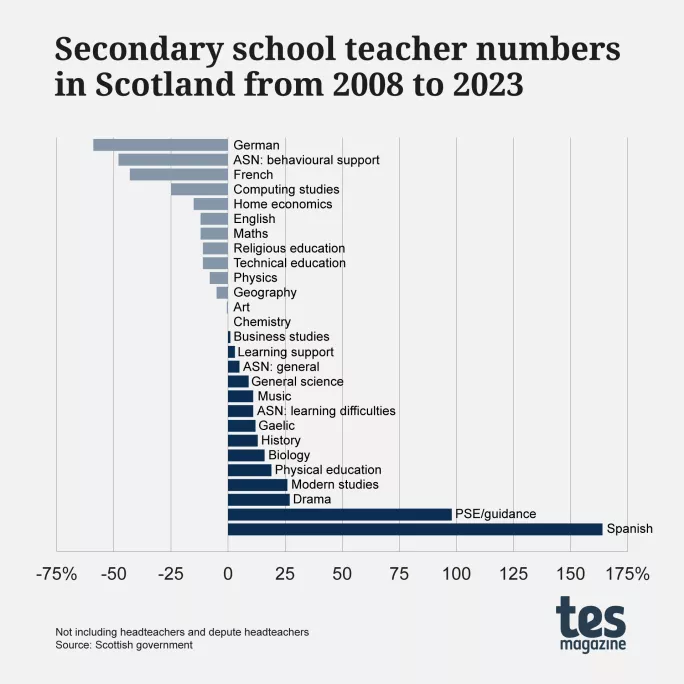
Teacher numbers: subject by subject change over 15 years

Teacher numbers have become a defining feature of the political jousting around Scottish education in recent times.
The Scottish government has promised to increase teacher numbers by 3,500 by 2026, but official figures in December showed that they had actually dropped for the second year in a row.
Then, in March, a Tes Scotland exclusive shone a light on councils’ explanations for falling teacher numbers, weeks after the issue had been reignited by the emergence of plans in Glasgow - Scotland’s largest local authority - to cut hundreds of teaching posts.
Coverage of the issue tends to focus on overall teacher numbers: the government tries to keep attention on its efforts to increase them in recent years, while opponents prefer to compare current numbers with the higher figures recorded when the SNP came to power in 2007 (that year’s census recorded 55,100, while the 2023 figures published in March this year showed 54,033).
Teacher numbers by subject
But what trends emerge when secondary teacher numbers are broken down by subject?
There is no universal trend in the figures published in March, which extend back to 2008: some subjects have considerably fewer teachers now, some have considerably more, and some have remained at much the same level.
An obvious question is how this relates to pupil numbers, with a fall in teacher numbers perhaps easier to stomach if there were also fewer pupils. However, the data published last month showed there were 313,061 secondary school students - up 3 per cent from the 303,978 recorded for 2008.
- Related: What’s behind PE’s remarkable rise in Scotland?
- Languages: Saving Scotland’s ‘languages ecosystem’ from collapse
- Computing: How can computing be saved in Scottish schools?
We have looked at the breakdown by individual subject, comparing teacher numbers in 2008 and 2023 in 27 subjects (see graph below).
We only looked at subjects that had at least 50 teachers in a subject in both 2008 and 2023 and that had comparable data for the two years in question, spanning Gaelic (64 teachers in 2023) and English (2,632 teachers in 2023).
The Scottish government figures relate to the main subject taught by a teacher and exclude headteachers and depute heads.
So, what does our analysis show?
Modern foreign languages
One of the most noticeable trends has been in languages. French had the seventh-most teachers in 2008 (1,070) but in 2023 it had the 16th-most (613), after a fall of 43 per cent.
German, meanwhile, from a far smaller starting point, has experienced the biggest percentage decline of any subject (58 per cent) and seems in terminal decline in Scottish schools, with a fall from 180 teachers in 2008 to 74 in 2023.
While Spanish offsets the overall narrative in languages to some degree, with the largest percentage rise of any subject (164 per cent) - this is in relation to only 64 teachers in 2008, going up to 169 in 2023.
The overall picture for languages does not look likely to change soon, with the recruitment of student language teachers far below target levels, as highlighted by two experts writing for Tes Scotland last week, Fiona Barclay and Fhiona Mackay.
They said: “The progression pipeline of languages learners is fractured and the ecosystem of languages, moving from young learners through to national exams, university and teacher training, is at risk of collapse.”

Today, Scottish Liberal Democrat education spokesperson Willie Rennie said it was “extremely troubling to see such a sharp decline in Stem subject teachers” (science, technology, engineering and maths).
He pointed to falls between 2008 and 2023 in teacher numbers for computing studies (25 per cent down), maths (12 per cent), technical education (11 per cent) and physics (8 per cent).
However, this is not the full picture for Stem: biology has had a 16 per cent rise in teacher numbers since 2008 (from 1,177 to 1,370), while chemistry has remained at the exact same number (989).
Other subjects to experience significant falls in teacher numbers between 2008 and 2023 include home economics (down 15 per cent, from 978 to 832) and the subject with the most teachers of all, English (down 12 per cent, from 2,992 to 2,632).
Subjects heading in the other direction include PE (up 19 per cent and now the only subject besides English and maths with more than 2,000 teachers, at 2,061). There have also been big rises for drama (up 27 per cent), modern studies (up 26 per cent), history (up 13 per cent) and music (up 11 per cent).
However, the biggest rise of all - aside from Spanish - is in “PSE (personal and social education)/guidance”, which may reflect the greater prioritisation now being given to pastoral support in Scottish schools.
This group of teachers totalled 300 in 2008 but had risen to 593 in 2023 - up 98 per cent.
For the latest Scottish education news, analysis and features delivered directly to your inbox, sign up to Tes magazine’s The Week in Scotland newsletter
You need a Tes subscription to read this article
Subscribe now to read this article and get other subscriber-only content:
- Unlimited access to all Tes magazine content
- Exclusive subscriber-only stories
- Award-winning email newsletters
- Unlimited access to all Tes magazine content
- Exclusive subscriber-only stories
- Award-winning email newsletters
You need a subscription to read this article
Subscribe now to read this article and get other subscriber-only content, including:
- Unlimited access to all Tes magazine content
- Exclusive subscriber-only stories
- Award-winning email newsletters
- Unlimited access to all Tes magazine content
- Exclusive subscriber-only stories
- Award-winning email newsletters
topics in this article



